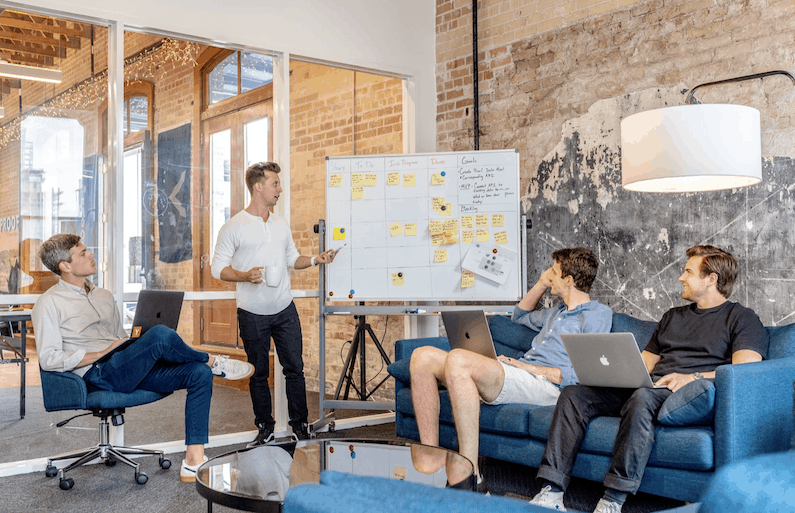You have an idea for an amazing product, and you can’t wait to share it with the world. But before you rush into your new startup adventure, consider these 5 important design-centric ideas to ensure a successful product launch.
When it comes to product development, you can’t underestimate the importance of design. Companies that put design central to their mission reported 219% greater returns than non-design conscious companies. And these are top 500 companies you would recognize, such as Apple, Nike, Disney, and Herman Miller.
These companies consistently practice applied design thinking to product design. They consider it a pivotal part of the process, from end to end, and not just during the design phase. Follow the lead of these companies and use design thinking to give your own business the competitive edge.
Design Thinking
But first, what is design thinking? Design thinking starts with looking first at business objectives through the lens of consumer need. They identify problems and determine what would define a solution for the target consumer.
Most product designers follow the Design Thinking model developed by the Hasso-Plattner Institute of Design at Stanford.
The 5 Stage Design Thinking Model
In this model, designers explore five stages to guide their actions. These five stages are:
- Empathize
- Define
- Ideate
- Prototype
- Test
Empathize
Empathy is the first critical step in design thinking. It helps designers remove their assumption about how things work, and instead focus on how consumers view things. It may mean observation and engagement with target consumers to gain an understanding of their experience, or motivations. Designers need a deep personal appreciation of the customer experience.
Define
In this phase, you are assembling the information you’ve gathered to focus on the central problem you’ve identified from the consumer point of view. You will need to set aside company objectives for the moment. For example, it’s not about increasing market share of aftermarket backup cameras for pickup trucks. It’s about making driving safer for truck drivers.
Ideate
You are now ready to start coming up with ideas. This is where new solutions will come into play. Teams will brainstorm as many ideas as possible. This should be an exercise in free thinking to develop several potential solutions. No idea is a bad idea at this point, get everything out onto the table. Often the final solution is actually an improvement upon an originally failed idea.
If possible, bring together a multi-disciplinary team for this process. Research and development are no longer in a silo kept away from other departments in your company. Often bringing in someone from the customer service department will bring insight into the most often asked questions or frustrations of your end user.
Prototype
The design team will then narrow down the list of ideas to a manageable number of ideas that is considered viable. They are then tasked with producing inexpensive versions of the product. These prototypes enter the experimental phases and are often tested by internal resources outside of the initial design team.
As problems or objectives are discovered, they are investigated. Designers will build on interactions to improve the prototype designs. The successful prototypes are then sent on to testing.
Test
Things often behave differently in the wild. Despite rigorous internal testing, it’s important to let consumers evaluate your products and see if they do work the way you intended. Real-world testing often identifies things you never anticipated.
Testing is used to understand how people think, feel, and interact with products. This puts what you learned during the empathize phase into action to see if your initial observations were correct.
The testing phase often leads to refinements. In some cases, it may take you back to the ideation phase with a better understanding of consumer problems. The more times you continue this cycle, the better your final product will be as it will truly solve your customer’s problem.
Avoid Product Fails
More than 40 percent of products launched fail to connect with consumers in a meaningful way. That’s why product design never ends. You need to continually optimize your products in a cycle of continuous development.
As mentioned, often after the testing phase you will need to go back to the drawing board in the ideation phase. This will require more brainstorming, tweaking and perfecting. Each time you analyze and refine your product you are one step closer to finally launch the perfect product to your audience.
If this never-ending process of product design is not in your wheelhouse, or you just don’t have time, consider hiring a product designer. These are creative, powerhouse, go-getters that are becoming more and more in demand. They can combine user experience with market research and your brand to create the perfect storyboard for your product launch.
No longer are the branding and marketing departments siloed away from the research and development department. A quality product designer will combine each of these aspects of your business to ensure a beautiful, and useful, product.
Remember, design thinking is about people not the product. Your product should solve a problem for your ideal customer. Without knowing your ideal customer, you cannot solve their problem. So, before you jump straight into designing your new startup product, carefully consider these 5 steps so that you ensure you are creating a quality product that will solve your customer’s problem.



